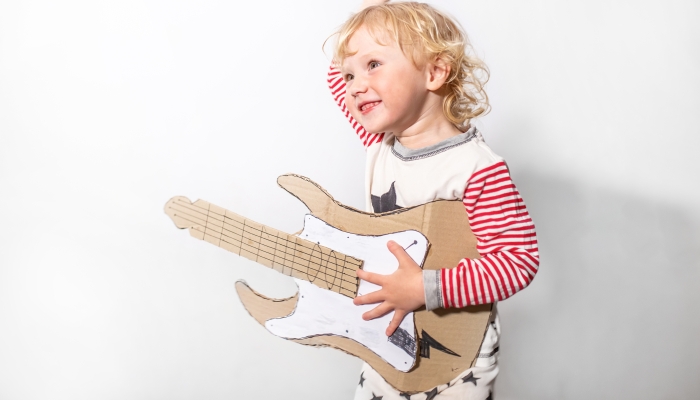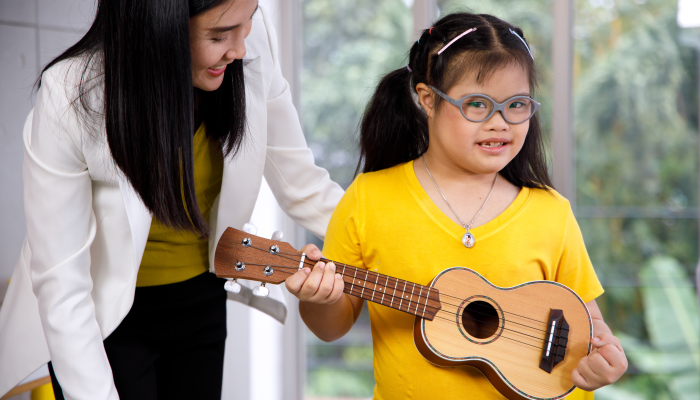The Cajon: A Box That’s a Drum That’s a Box!

On the coast of Peru, there’s a box that’s played like a drum called a cajón (that’s the Spanish word for big box). Traditionally, it’s something you sit on and play with your hands.
Playing with a square drum rather than a round shaped drum can be a great way to introduce drumming to children with limited motor abilities, too. You can enjoy and teach the basics of hand drumming with a small sturdy box placed on a lap, a desktop, or even tied gently into place on a high chair.
 The story behind the cajón is actually a very sad one. When slaves were brought to Peru by the Europeans, the slave owners were very cruel. They took away the African drums from the slaves hoping that it would break their spirit. Instead, they drummed in secret and used whatever they could find—packing crates, dresser drawers, or simple wooden boxes and they kept their heritage and traditions alive. It’s testament to how the creative spirit can emerge and express itself even under the most difficult and daunting of circumstances.
The story behind the cajón is actually a very sad one. When slaves were brought to Peru by the Europeans, the slave owners were very cruel. They took away the African drums from the slaves hoping that it would break their spirit. Instead, they drummed in secret and used whatever they could find—packing crates, dresser drawers, or simple wooden boxes and they kept their heritage and traditions alive. It’s testament to how the creative spirit can emerge and express itself even under the most difficult and daunting of circumstances.
So being creative with music and even the shapes or sizes of your own drums is something any parent or caregiver can experiment with.
A box, a soundhole, and decoration
Choose a size of box that will work well for your child. A shoebox makes a great lap cajón; a 12 x 8 x 2 shipping box works great for a desktop or high chair cajón. Any sturdy recycled box is great to place on the ground next to your drumming child.
Traditional cajónes use a soundhole. If the box is going to sit on your lap, you can cut a soundhole out of the bottom and notice the difference in the tone when the instrument is played. If your cajón will sit on a high chair or desktop, then a soundhole won’t make much of a difference.
Decorate your cajón if you want to make it more fun or fanciful or to indicate the areas where the sound will change when stuck with your palm or tapped with your fingers. Experiment with tactile paints or high contrast colors for kids with low vision.
Now, on to the fun part….
Playing a cajón
 Just like most hand drums, you get two basic sounds from a cajón. Hit the center area of your box with the palm of your hand and you’ll get a “dum” or “uh” sound. Tap the drum’s surface closer to the edges with your fingers (or the area right below your fingers) and you’ll get a light “bek” or “ah” sound.
Just like most hand drums, you get two basic sounds from a cajón. Hit the center area of your box with the palm of your hand and you’ll get a “dum” or “uh” sound. Tap the drum’s surface closer to the edges with your fingers (or the area right below your fingers) and you’ll get a light “bek” or “ah” sound.
Mix the sounds to make patterns. Basic ones are easy for anyone to master. You can play the center and the edge, back and forth and try that fast and slow. Then begin playing patterns that might seem a bit more complicated, but are really easy to explore.
For instance, playing this simple pattern fits really well with a song like “Twinkle, Twinkle Little Star”:
- Edge – Edge – Center (repeat)
- bek – bek – dum (repeat)
- ah – ah – uh (repeat)
One of the fun things about this type of easy drum is that you can play it along with your child, for your child, or have your child play the patterns for you. For example, you can sit your child on your lap and put his or her hands on yours as you play the patterns together. Or you can learn the pattern for a song like Twinkle, Twinkle and ask your child to sing it for you. In the same way, they can play and you can sing. It’s a fun way of mastering a skill while working together with someone you love.
If that seems too structured, remember—it’s a drum! You can let your child experiment with sounds and patterns, play along with favorite music, or even create a few cajónes and experiment to see which ones sound best to his/her ears. You can also make an extra cajón for yourself and jam along with your child showing them that people can sync up to different parts in a rhythm and still be in step with a each other. It’s a great lesson.
You also might want to play some call and response games. You begin by playing a pattern and your child can try to repeat it. Or your child can play a pattern and you must listen and try to match it. For this game, I recommend you start simple and work your way up from there! You might be surprised by how kids can shine at this type of activity and enjoy playing “beat the parents!”
If your homemade box drum breaks, make another one. If your child loves it and wants a “real” cajón, you can build one from wood with basic woodworking skill or e-mail me and I can connect you with a craftsman who creates child-size cajónes that sound just great. Part of the fun of exploring any new instrument is making this whole process your own and suiting it to the needs and delights of your child and your family.
Would you like to hear a cajón or a song sung with cajón? Visit www.dariamusic.com/cajon.php where you can also color a cajón on the computer, get a detailed pdf for this craft, or explore similar instruments that are easy to make and play at home.
Experiment and enjoy!
Award-winning children’s performer, Daria (Daria Marmaluk-Hajioannou), has five CDs that have won national honors. She has the most awesome job of traveling the world to sing for kids and peace. Her website, located at dariamusic.com, was given a 2009 Parents Choice Award for its musical and cultural content.
Read this article in Arabic: حيوا-السيدة-العمياء
Related Posts

Music Play
5 Fun DIY Musical Instruments for Kids
Looking for a rainy day activity you can do on a budget? Get your little rock stars into these easy, crafty DIY musical instruments with stuff you have at home.

Autism, Music Play
6 Ways Music Therapy Can Support Children With Autism
By harnessing the power of music, autistic children can develop communication, social, emotional, cognitive, and motor skills. Here’s how!

Music Play
Music and Movement: Enhancing Preschool Learning Through Songs
Music and movement activities for preschoolers can help enhance their cognitive skills and brain development while developing social, emotional, and academic skills.